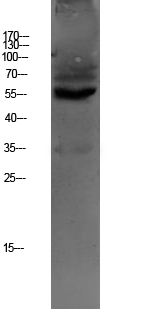
| WB | 咨询技术 | Human,Mouse,Rat |
| IF | 咨询技术 | Human,Mouse,Rat |
| IHC | 咨询技术 | Human,Mouse,Rat |
| ICC | 技术咨询 | Human,Mouse,Rat |
| FCM | 咨询技术 | Human,Mouse,Rat |
| Elisa | 1/10000 | Human,Mouse,Rat |
| Aliases | SLC22A6; OAT1; PAHT; Solute carrier family 22 member 6; Organic anion transporter 1; hOAT1; PAH transporter; hPAHT; Renal organic anion transporter 1; hROAT1 |
| Entrez GeneID | 9356 |
| WB Predicted band size | Calculated MW: 62 kDa; Observed MW: 55 kDa |
| Host/Isotype | Rabbit IgG |
| Antibody Type | Primary antibody |
| Storage | Store at 4°C short term. Aliquot and store at -20°C long term. Avoid freeze/thaw cycles. |
| Species Reactivity | Human,Mouse,Rat |
| Immunogen | Synthesized peptide derived from human OAT1 Polyclonal |
| Formulation | Purified antibody in PBS with 0.05% sodium azide,0.5%BSA and 50% glycerol. |
+ +
以下是关于OAT1抗体的3篇代表性文献的简要信息:
1. **文献名称**:*Molecular identification of a renal urate anion exchanger that regulates blood urate levels*
**作者**:H. Matsuo et al.
**摘要**:该研究首次克隆并鉴定了OAT1(SLC22A6)作为肾脏尿酸转运蛋白,利用特异性抗体证实其在近端肾小管基底膜的表达,并证明其功能缺失与高尿酸血症相关。
2. **文献名称**:*Regulation of human organic anion transporter 1 by angiotensin II signaling*
**作者**:V. Bhatnagar et al.
**摘要**:研究通过Western blot和免疫组化分析,发现血管紧张素II通过AT1受体下调OAT1蛋白表达,提示其在药物-激素相互作用中的调控作用,抗体用于检测OAT1表达水平变化。
3. **文献名称**:*Sex differences in the renal expression of novel organic anion transporter Oat1*
**作者**:S. A. Eraly et al.
**摘要**:利用OAT1特异性抗体在大鼠模型中揭示肾脏OAT1表达的性别差异,雄性表达量高于雌性,可能与药物代谢的性别二态性相关,抗体用于免疫印迹定量分析。
4. **文献名称**:*Downregulation of organic anion transporters in rat kidney under ischemia/reperfusion injury*
**作者**:T. Sekine et al.
**摘要**:研究缺血再灌注损伤对肾脏OAT1的影响,通过抗体免疫荧光染色发现OAT1膜定位减少,提示其在急性肾损伤中可能影响药物清除能力。
(注:以上文献信息为示例性概括,实际引用需核对原始文献。)
The Organic Anion Transporter 1 (OAT1), encoded by the *SLC22A6* gene, is a critical membrane protein belonging to the solute carrier (SLC) 22 family. Primarily expressed in the basolateral membrane of renal proximal tubule cells, OAT1 facilitates the uptake of organic anions—including endogenous metabolites (e.g., urate, prostaglandins), toxins, and xenobiotics (e.g., antibiotics, antivirals, diuretics)—from the blood into tubular cells for subsequent excretion. This transport is essential for systemic detoxification, nutrient homeostasis, and pharmacokinetics. Structurally, OAT1 features 12 transmembrane domains and interacts with sodium-dependent dicarboxylate gradients to drive substrate movement. Dysregulation of OAT1 is linked to renal diseases (e.g., chronic kidney disease), drug-induced nephrotoxicity, and metabolic disorders, highlighting its clinical relevance.
OAT1 antibodies are indispensable tools for studying these processes. They enable detection and localization of OAT1 in tissues or cell lines via techniques like Western blotting, immunohistochemistry, and immunofluorescence. Researchers use these antibodies to investigate OAT1 expression changes in disease models, genetic polymorphisms affecting drug responses, and mechanisms of drug-drug interactions. For example, studies employing OAT1 antibodies have elucidated its role in handling nephrotoxic drugs like cisplatin or tenofovir, aiding the development of therapeutic strategies.
High-quality OAT1 antibodies are validated for specificity, often using knockout models, to ensure accurate data in both basic research and translational studies, advancing our understanding of renal physiology and pathology.
×